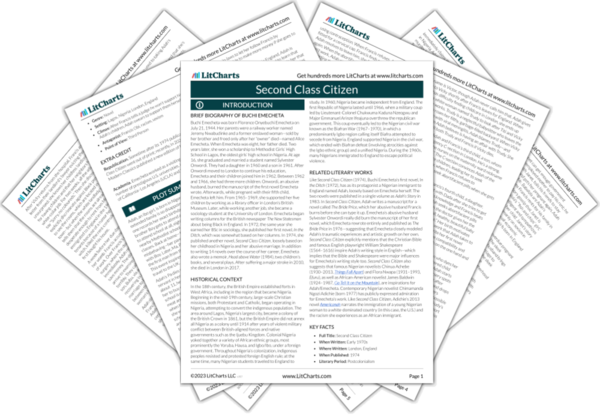Many novels represent motherhood and art as antithetical: mothers, bound to their children, lack the time and freedom required by the artistic life. By contrast, Second Class Citizen represents mothering and making art as analogous, complementary activities. Adah, a young Nigerian woman who immigrates to the UK in the early 1960s, marries Francis when they are both teenagers and immediately begins having his children. By age 20, while working full-time almost continuously, Adah has had three children, the last of whom, a son named Bubu, requires an emergency Caesarian section that nearly kills her. After a contraceptive cap and abortifacient pills fail Adah during her fourth pregnancy, she gives birth to her daughter Dada and decides she must take a real break from paid work. During this break, Adah recalls her old aspiration to write—so, for five months, all she does is breastfeed Dada, care for her other young children, and work on a novel manuscript, The Bride Price. Completing this first novel manuscript feels to Adah like giving birth: writing and maternity are, for her, the two most fulfilling activities of her life. When she mentions this to a supportive former coworker, Bill, he calls the novel her “brainchild.” This analogy gives Adah the strength to leave her abusive husband Francis when he burns her novel manuscript: she feels that he has essentially killed her child and so she must leave him—not only to pursue art but, implicitly, to protect her human children, who witness Francis violently abuse her. Adah’s maternity leave allows her to fulfill her aspiration of becoming a writer, while Francis’s hostility to her writing motivates her to divorce him, thus freeing her children from an abusive household. In this way, counter to a common cultural narrative, Second Class Citizen represents maternity and art as allied practices.
Motherhood and Art ThemeTracker

Motherhood and Art Quotes in Second Class Citizen
She was not even quite sure that she was exactly eight, because, you see, she was a girl. She was a girl who had arrived when everyone was expecting and predicting a boy. So, since she was such a disappointment to her parents, to her immediate family, to her tribe, nobody thought of recording her birth. She was so insignificant.
Among her people, she could have killed Trudy, and other mothers would have stood solidly behind her. Now, she was not even given the joy of knocking senseless this fat, loose-fleshed woman with dyed hair and pussy-cat eyes. She belonged to the nation of people who had introduced “law and order.”
“I brought my children here to save them from the clutches of your family, and, God help me, they are going back as different people; never, never are they going to be the type of person you are. My sons will learn to treat their wives as people, individuals, not like goats that have been taught to talk.”
She worked out a timetable, and found that she could manage to have three hours of quiet each afternoon. Then her old dream came popping up. Why not attempt writing? She had always wanted to write. Why not?
Francis could kill her child. She could forgive him all he had done before, but not this.











